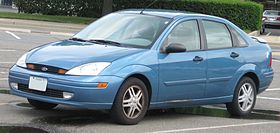Minivan is an American car classification for vehicles designed to transport passengers in the rear seating row(s), with reconfigurable seats in two or three rows. The equivalent terms in British English are Multi-purpose Vehicle (MPV), people carrier and people mover. Minivans often have a 'one-box' or 'two-box' body configuration, a higher roof, a flat floor, a sliding door for rear passengers, and high H-point seating.

The Ford Focus is a compact car manufactured by the Ford Motor Company and created under Alexander Trotman's Ford 2000 plan, which aimed to globalize model development and sell one compact vehicle worldwide. The original Focus was primarily designed by Ford of Europe's German and British teams.

The Ford Transit is a range of light commercial vehicles produced by Ford since 1965. Sold primarily as a cargo van, the Transit is also built as a passenger van, minibus, cutaway van chassis, and as a pickup truck. Over 8,000,000 Transit vans have been sold, making it the third best-selling van of all time and have been produced across four basic platform generations, with various "facelift" versions of each.

The Ford Fairmont is a compact car that was produced by Ford for the US and Canada markets for the 1978 to 1983 model years. The debut of the Fairmont and its Mercury Zephyr counterpart marked the launch of the long-running Ford Fox platform that would underpin twelve additional models and stay in production until 1993. Offered in a variety of body styles, the Fairmont succeeded the Ford Maverick, and was replaced by the front-wheel drive Ford Tempo for the 1984 model year.
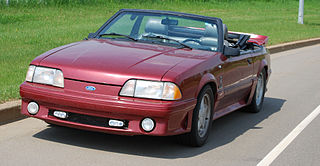
The Ford Fox platform is an automobile platform that was used by Ford Motor Company. Introduced for compact sedans in the 1978 model year, the Fox architecture was utilized for a wide variety of configurations for Ford and Lincoln-Mercury vehicles. In its original form, the platform was used until 1993, with a substantial redesign of the Ford Mustang extending its life through the 2004 model year. With the exception of the Panther platform, the Fox platform is the longest-produced vehicle architecture by Ford Motor Company.
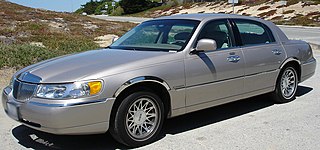
The Ford Panther platform is an automobile platform that was used by Ford Motor Company from the 1979 to 2012 model years. Following the downsizing of the General Motors B-bodies and C-bodies by two years, the Panther platform marked the end of production of sedans unencumbered by downsizing. Originally slated for discontinuation during the early 1980s, the Panther architecture was used for 33 model years, the longest-produced platform in North American automotive history.
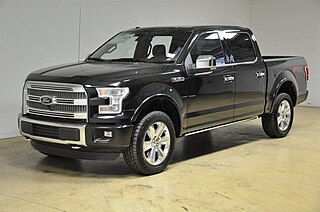
The Ford F-Series is a series of light-duty trucks and medium-duty trucks that have been marketed and manufactured by Ford Motor Company. In production since 1948, the F-Series includes full-size pickup trucks, chassis cab trucks, and commercial vehicles. As of 2019 production, the Ford F-Series includes the F-150 pickup, Class 3-5 Super Duty trucks, and the Class 6-8 Super Duty trucks. The most popular version of the F-Series is the F-150, now in its thirteenth generation.

The Ford LTD is a range of automobiles manufactured by Ford Motor Company for the 1965 to 1986 model years. Introduced as the highest trim of the full-size Ford model range, the LTD introduced options and features normally reserved for more luxurious Lincoln and Mercury models. The largest vehicle produced by Ford in North America for most of its production, the LTD was joined by the intermediate Ford LTD II from 1977 to 1979; the LTD II served as the replacement for the Torino/Gran Torino range. At various times throughout its production, the LTD range included two- and four-door pillared and hardtop sedans, a two-door convertible, and the Country Squire five-door woodgrain station wagon.

The Ford Courier name has been used on a variety of automobiles produced by Ford between 1952 to 2013.

The Ford Piquette Avenue Plant is a former factory located within the Milwaukee Junction area of Detroit, Michigan, in the United States. Built in 1904, it was the second center of automobile production for the Ford Motor Company, after the Ford Mack Avenue Plant. At the Piquette Avenue Plant, the company created and first produced the Ford Model T, the car credited with initiating the mass use of automobiles in the United States. Prior to the Model T, several other car models were assembled at the factory. Early experiments using a moving assembly line to make cars were also conducted there. It was also the first factory where more than 100 cars were assembled in one day. While it was headquartered at the Piquette Avenue Plant, Ford Motor Company became the biggest U.S.-based automaker, and it would remain so until the mid-1920s. The factory was used by the company until 1910, when its car production activity was relocated to the new, bigger Highland Park Ford Plant.

The Ford C-Max is a compact multi-purpose vehicle (MPV) produced by the Ford Motor Company since 2003. The Ford Grand C-Max has a longer wheelbase.
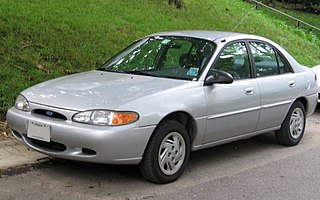
The North American variant of the Ford Escort is a small family/compact car introduced by Ford in 1980 for the 1981 model year. Adopting the "Escort" name used by Ford of Europe since 1968 along with the general design and layout of the third-generation European Escort, it was the successor of the Ford Pinto, which had a tarnished reputation for quality and safety after a widely publicized fuel tank defect. The Escort was one of Ford's most successful models in the 1980s, earning a much better reputation than the Pinto. The Escort was the single best-selling car in its second year in the United States and during most of that decade.
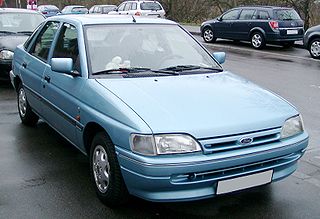
The Ford CE14 platform was a front wheel drive automobile platform used by the Ford Motor Company as the platform from third to sixth-generation European Ford Escort models, in the Ford Orion, in the first generation of North American Ford Escort, in the Ford Tempo, in the Ford EXP and in the Ford Verona. The Ford CE14 based Escort was replaced by the first-generation Ford Focus which was built on the then new Ford C170 platform.

Since debuting at the 2007 North American International Auto Show, the restyled North American second generation Ford Focus has been sold by Ford as either a two-door coupe and 4-door sedan — the hatchbacks and wagon were discontinued. The interior was redesigned, including new seats, a new dashboard design with message center atop of the dashboard, ambient lighting, dashboard panels that simulate brushed aluminum, and Ford's voice-controlled Sync audio/Bluetooth system. Also included in the redesign is a support beam behind the dashboard for extra structural rigidity. After the 2010 model year the Ford Focus coupe was discontinued due to slow sales.
In the context of the automobile industry, downsizing is a practice used to transition vehicles from one size segment to another. Often done in response for consumer and government demands to increase fuel economy, vehicle downsizing has been achieved through several methods. As product lines complete model cycles, during a redesign, automobile manufacturers reduce the exterior footprint of a vehicle to allow for weight reduction, shortening wheelbase and body length.

The Ford Focus , also known as the Focus Mk III, debuted at the 2010 North American International Auto Show as a 2012 model. The cars shown were a 4-door sedan and 5-door hatchback, also debuting a new 2.0L direct injection I4 engine. A 5-door estate (wagon) was previewed at the Geneva auto show a month later.

The Mazda Premacy is a compact MPV that was built by the Japanese manufacturer Mazda from 1999.
